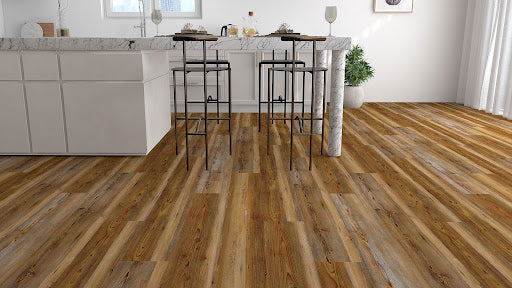
DIY Flooring
Share
Installing vinyl flooring in a kitchen involves carefully preparing the subfloor, choosing the right underlayment, and properly installing the vinyl planks or sheets. For click-lock vinyl plank flooring, start by trimming the first plank and laying it with a slight expansion gap from the wall. Attach subsequent planks using the angle-and-snap method. Sheet vinyl requires applying adhesive and carefully laying the material, ensuring it's properly bonded to the subfloor with a floor roller.
Detailed Steps for Click-Lock Vinyl Plank Flooring:
-
Prepare the Subfloor:
Clean the subfloor thoroughly and ensure it's level and free of debris.
-
Install Underlayment (Optional):
If desired, install underlayment according to manufacturer's instructions, taping the seams together. - Acclimate the Flooring:
Allow the vinyl planks to acclimate to the room's temperature and humidity for at least 48 hours.
-
Plan the Layout:
Plan the layout of the planks, starting with a straight edge and staggering the seams for a more natural look.
-
Install the First Row:
Trim the short tongue edge of the first plank and lay it with an expansion gap (about 1/4 inch) from the wall.
-
Attach Subsequent Planks:
Attach subsequent planks by holding them at an angle and inserting the tongue into the groove of the previous plank, then lowering it to snap them together.
-
Continue Laying Planks:
Continue laying planks in the first row, trimming the last plank as needed.
-
Start the Second Row:
For the second row, use the same angle-and-snap method, attaching them to the first row and to each other.
-
Trim and Install Border Planks:
Trim the border planks and leave an expansion gap between the planks and the walls.
-
Replace Baseboards:
Replace the baseboards to cover the expansion gap.
Detailed Steps for Sheet Vinyl Flooring:
-
Prepare the Subfloor: Clean and level the subfloor, addressing any imperfections.
-
Acclimate the Vinyl: Let the sheet vinyl acclimate to the room's temperature for at least 48 hours.
-
Lay Out the Vinyl: Carefully position the sheet vinyl in the room, folding it back on itself if needed.
-
Apply Adhesive (if needed): Apply the adhesive to the subfloor according to the manufacturer's instructions, using a notched trowel.
-
Cure the Adhesive: Allow the adhesive to reach the appropriate tackiness before laying the vinyl.
-
Lay the Vinyl: Carefully lay the vinyl into the adhesive, pressing firmly to remove air pockets.
-
Roll the Vinyl: Use a floor roller to ensure proper bonding and remove any air bubbles.
-
Finish the Edges: Trim the edges of the vinyl and seal them with a seam sealer (if required).
-
Install Moldings and Baseboards: Replace or install new moldings and baseboards.
Clean Up: Clean any adhesive residue and allow the adhesive to dry completely.
